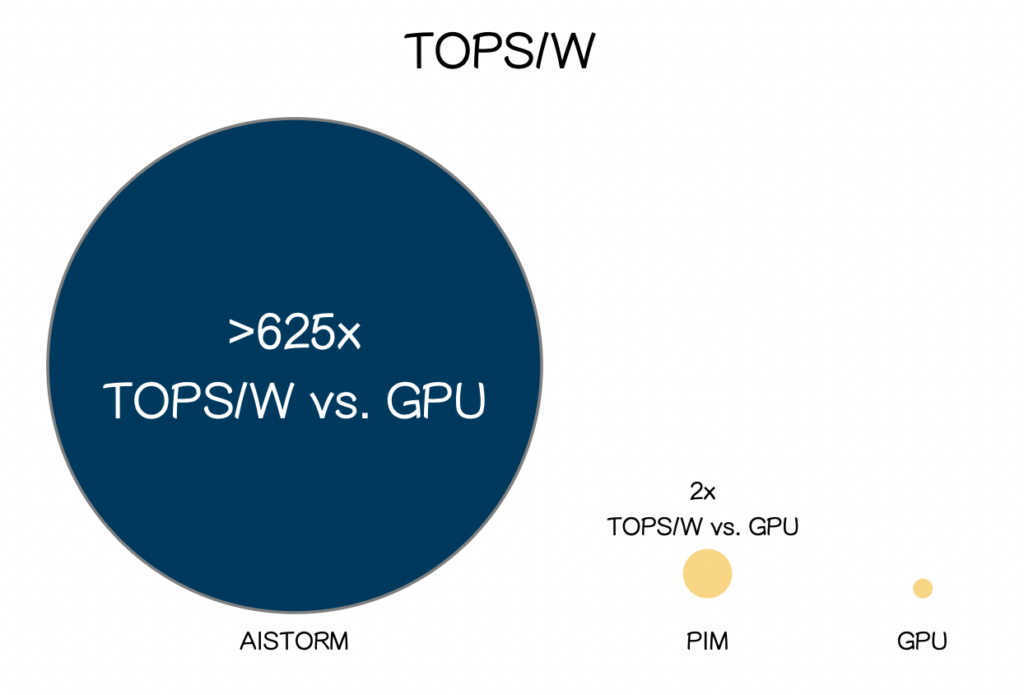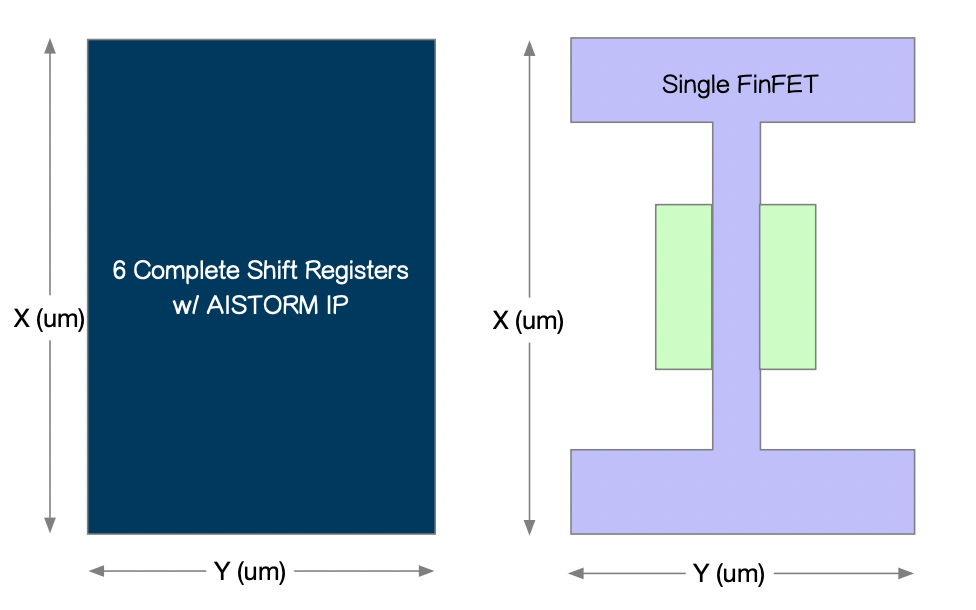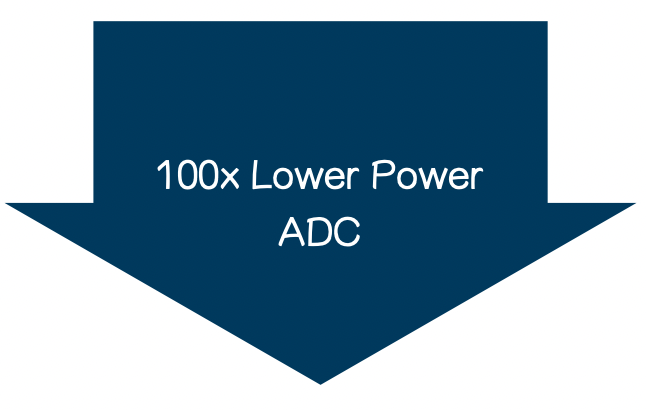AIStorm - Our IP / Your IC
Charge Domain Engineering

AIStorm has revolutionized modern day circuits through Charge Domain implementation. We have a portfolio of neural networks, ADCs, Digital Blocks, and Pixels based on novel charge domain concepts from 180nm down to 5nm.
Contact us for integration of this IP into your Integrated Circuit.
AIStorm Neural Network IP - Make Your Silicon Smarter
AIStorm's TOPS Advantage
The metrics TOPS/W (Tera Operations per Second per Watt) and TOPS/mm² (Tera Operations per Second per square millimeter) are crucial for evaluating the efficiency of hardware for neural networks. TOPS/W measures energy efficiency, indicating how much computational performance is achieved per unit of power. This is especially vital in power-constrained applications like mobile devices, edge AI, and data center environments, where energy consumption directly impacts operational costs and thermal management. On the other hand, TOPS/mm² evaluates spatial efficiency, reflecting how much computational power is delivered per unit of chip area. This metric is key for silicon design, enabling hardware engineers to optimize for compactness and performance density, critical for integrating AI accelerators into smaller or cost-sensitive form factors. Together, these metrics provide a balanced view of a hardware’s ability to deliver high performance, energy efficiency, and compactness, aligning with the increasing demands of modern AI workloads.

AIStorm has a factor of up to 625 times higher TOPS/W when compared to GPUs and 125 times higher TOPS/W when compared to Process In Memory, providing much higher performance for the same power utilization. Note that many technologies state their TOPS/W performance only for the neuron and not for the other supporting functions; when evaluating only our charge domain neuron, we are well in excess of 1000 TOPS/W performance.
Additionally, AIStorm’s IP excels at area utilization for our neural network architectures, which is discussed more in the Recursive Advantage section. At a 40nm technology node, our IP has >43 TOPS/mm size.
Proven Neuron IP Performance

As a simplified illustration of AIStorm’s Neuron, the diagram on the left shows a time pulse going into our neuron with weights and summation operation.
This is also used as a way to test the simple operation including Linearity and RELU function as shown in the lower plots.
AIStorm’s Neural Network IP delivers proven linearity performance, ensuring consistent and reliable output across a wide range of input conditions. This proven linearity minimizes errors and distortions, making it ideal for applications requiring high precision, such as autonomous systems, edge AI, and data analytics. By leveraging innovative circuit designs and advanced optimization techniques, our IP maintains predictable behavior even under varying workloads and power constraints. This translates to improved accuracy, reduced debugging time, and faster time-to-market for your AI-driven products. Trust our Neural Network IP to provide the stability and performance your applications demand.

AIStorm - Charge Domain Digital
Low Power Digital
AIStorm’s Charge Domain Digital revolutionizes digital circuit design with an average 30x lower power consumption compared to traditional transistor-based implementations at the same technology node. This breakthrough spans multiple circuit types, demonstrating unparalleled energy efficiency without compromising performance. By reducing power demands, AIStorm addresses critical challenges in thermal management, battery life, and sustainability for modern electronics. Its innovative approach positions it as a game-changer in industries ranging from consumer devices to high-performance computing. With Moore’s Law slowing, AIStorm provides a clear path to continued progress in energy-efficient digital systems.

30x Smaller Foot Print

AIStorm’s Charge Domain Digital redefines compactness in digital circuit design, fitting six shift registers into the footprint of a single FinFET device at the same technology node. This remarkable density leap enables significant space savings, paving the way for more functionality in smaller form factors. Its design innovation allows for advanced miniaturization, crucial for applications in wearables, IoT devices, and high-density computing. By maximizing efficiency within the same technological constraints, AIStorm delivers a transformative solution for industries demanding smaller, more powerful electronics. It sets a new standard for achieving greater functionality in the ever-tightening constraints of semiconductor scaling.
AIStorm - Charge Domain Analog to Digital Converter
Sigma Delta Converter
A sigma-delta ADC (Analog-to-Digital Converter) is a high-resolution solution ideal for applications requiring precision and noise immunity. By oversampling the input signal and employing noise shaping, it achieves exceptional accuracy while minimizing quantization noise within the desired frequency band. These features make it a popular choice for audio, industrial measurement, and sensor interface applications.
AIStorm has introduced a radical new way of implementing this ADC utilizing Charge Domain techniques, leading to ultra small and low power performance.
Pixel-Sized ADC
AIStorm’s patented technology enables pixel-scale ADC sizes, shrinking down to 1x1um geometries.
Powerfully Low Power
AIStorm’s sigma delta ADC Architecture, utilizing charge domain techniques, has over 100x lower power than traditional architectures in the same technology node with same SNRQ and other metrics.
The AIStorm power for a 10bit ADC in 40nm is <5uW/Conversion with high SNRQ and configurable conversion rate.

AIStorm - Pixel Development IP
With AIStorm’s excellence in charge domain engineering, Pixel Development is a natural fit into the IP Portfolio. AIStorm has High Dynamic Range and Ultra Fast Pixel Technology.
Enabling Ultra Fast Frame Rates
High frame rates are essential for delivering a smooth and immersive experience across various industries, from gaming and film to professional applications like simulation and virtual reality. By increasing the number of frames displayed per second, motion appears fluid and lifelike, reducing visual fatigue and enhancing realism. This is especially critical in fast-paced environments such as esports, where split-second reactions can mean the difference between victory and defeat, or in cinematic storytelling, where subtle movements and transitions bring stories to life.
Beyond entertainment, high frame rates are pivotal in industries like healthcare and defense, where precision and clarity in simulations and real-time operations can impact critical decisions. As display and processing technologies advance, embracing higher frame rates is key to meeting the demands of both performance and visual excellence.
AIStorm’s Cheetah sensor runs at speeds up to 260,000 frames per second. This is enabled by AIStorm’s unique pixel which performs in-pixel charge to digital operations
High Dynamic Range without Motion Blur
Most small-pixel (<2um pitch) utilize a multi-frame approach for increase High Dynamic Range for photographic cameras utilizing by utilizing a partial frame buffer with multiple staggered shutter pointer and readouts. This not only increases the size and power of the image sensor, it also causes colorized motion blur of fast moving objects due to the different exposures capturing different points in time of the moving objects (as shown in the neighboring image).
AIStorm has designed a 1.0um pixel which is able to capture all ranges of exposure in the scene in a single capture, eliminating the issue of colorized HDR motion blur.
